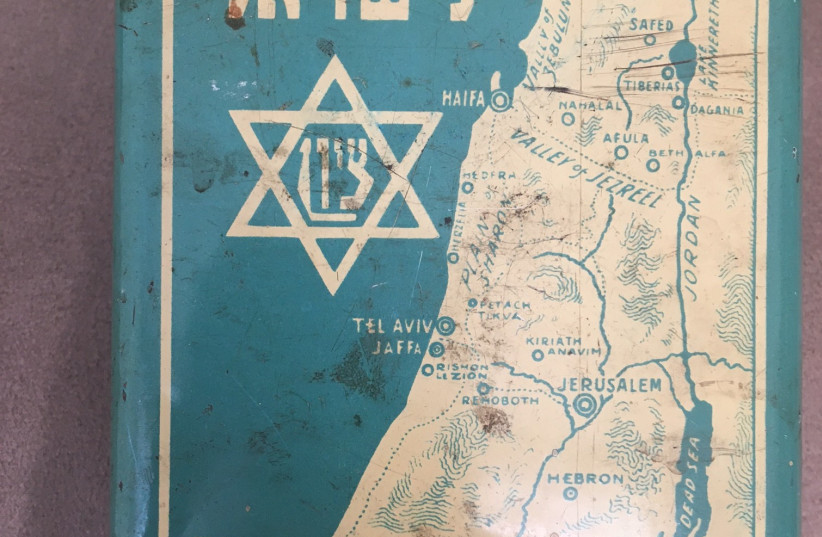As a fan of newspapers in the 19th and 20th centuries online, I quickly learned of the papers’ interest in Jews returning to the Holy Land. There are poignant entries in the general press describing how a barren Palestine would only blossom again when the “Hebrews” lived there again.
In The San Francisco Call daily, July 14, 1908, this appeared, “At the convention of Federation of American Zionists [pre ZOA] in Atlantic City, it was decided that in addition to what is collected [for organization in general] now there is the following system relating to the planting of olive trees in Palestine to be known as the Herzl Olive Grove.” This was to be done in Hulda, a land site that had already been purchased.
The next paragraph solves the mystery of how people, who contribute, in these modern times, can request to “see” the trees they have paid to have planted.
“If a man,” the newspaper reads, “pays $1.50, an olive tree is planted in the Herzl forest. The name of the donor is inscribed in the national fund [JNF] book.”
The following answers all the contemporary donors’ questions. “The tree will belong to the national fund, but will be named after the man who paid for it.”

The results of this initial planting can be found in Keren Kayemeth LeIsrael-JNF records. “Of the first 12,000 olive tree saplings planted, only 3,000 took root.” At that point, planting of olive trees was halted.
NOT MANY of us in the Geffen family have been tillers of the soil. However, Reuven Geffen, my first cousin, earned a bachelor’s degree in agriculture at Cornell University in New York State. He made aliyah 40 years ago, first living in Kibbutz Sde Boker, working in vegetable seed production for a local company. Today, he and his wife, Yaffa, live on Moshav Nir Moshe.
Reuven shared with me his personal activities in regard to trees on his farming area. “A few years ago I decided to plant trees on our meshek [farm]. Planting trees is important for our ecosystem and also contributes to saving some of our biodiversity.”
Sadly, Reuven’s son Idan fell while serving in the IDF. “In this way, I also wanted to honor and perpetuate Idan’s memory – he loved climbing trees.”
Here is his description of what he is doing today. “I planted on a five-dunam [0.5 hectare] field about 130 trees and shrubs representing more than 100 different species – including the species that are endemic to Eretz Yisrael as well as related species from around the world and other species that have been acclimated for planting here. These are almost all trees that grow wild and/or used for wood, other traditional byproducts, or landscaping – no fruit trees.
“My purpose is to help preserve these species as some of them are rare, and eventually to develop it as a learning park so people can be introduced to the great variety of trees and their importance. Plus there will be signs and explanations, and tours.”
In explaining that his work reflects the locale where he lives, Reuven noted the following:
“Since the forest is in the Negev, I have to add supplemental irrigation as most of the species need more water than is received here in rainfall. I also have to keep the weeds down until the trees provide enough shade to do that themselves.”
Reuven has set high goals for himself, and I, his cousin, hopes that he succeeds.
A CLOSE friend, Reform Rabbi Stuart Geller, made aliyah 22 years ago, retiring early from his pulpit in Lynbrook, New York. There, 40 years ago, he organized a most unusual Tu Bishvat celebration.
“Our Sunday school handed out bonsai trees to the lower grades in honor of Tu Bishvat. I would imagine that there must have been a Tu Bishvat Seder too.”
Geller described what happened to his family bonsai tree. “Our youngest, Ari, received a tree back then and keeps on taking care of it. Today,” he explains to me, “that tree has lived in Wisconsin, New York, Wisconsin again, New York City, Washington, DC, back to New York and now back to DC.
“Invariably,” he reports with a gleam in his eye,” when we go to visit Ari, we stop by the little tree basking in the sunlight and say, “Shalom, Mr. Tu Bishvat, may you live a long life.”
<br>Tribute
This story is dedicated, on his first Yahrzeit, to the great collector Ezra Goredesky z”l, a friend for 40 years. The pioneering “Kitchen Archeologist,” he discovered Hebrew manuscripts in book bindings.
Among the more than 1,000 objects, books and manuscripts he donated to the National Library, the Israel Museum and other institutions around the world, I was always interested in the George Washington cup from the 19th century, now at Mount Vernon, Virginia. His collection of tea tokens from around the world, even those issued to Egged drivers, was fantastic.
However, Ezra was much more to the Geffens.
Our family adopted him. For four decades, he was at weddings, bar mitzvahs, many of my birthday parties where, three years ago, he celebrated his 90th birthday with us.
He and Ori, our grandson, had a special bond since Ori made a prize-winning student film about him. In it, Ezra is very much alive; he espouses his collective philosophy on life. (See his wonderful mischievous smile in the movie: vimeo.com/62141618)
When he made aliyah in 1960, he befriended an American woman, Rebecca Affachiner, the “Betsy Ross of Israel.” Her handmade Magen David flag, fashioned from a bed sheet and colored with crayon, was first flown on May 14, 1948, and every year thereafter when Rebecca was alive. Ezra inherited the flag and donated it to the Ben-Gurion Archive in 2019, where it adorns David Ben-Gurion diaries.
